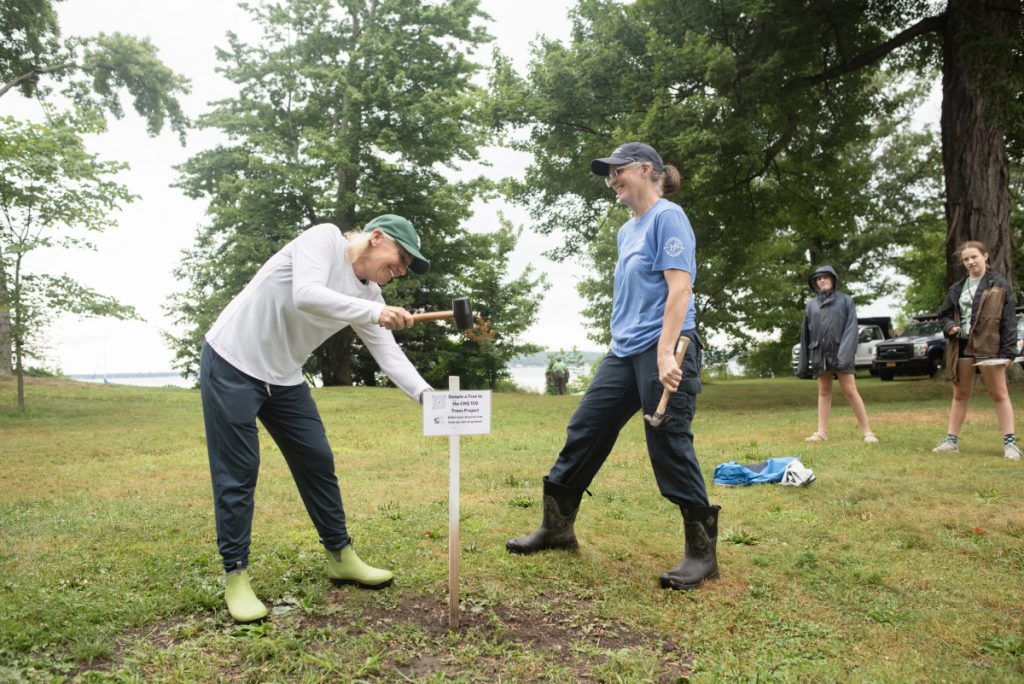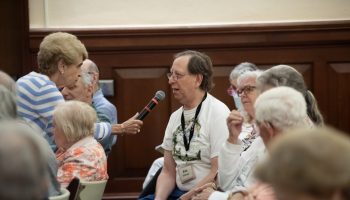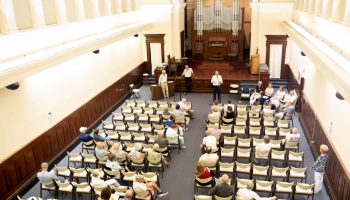
Patricia Beagle
Contributing Writer
Visitors often remark about Chautauqua Institution’s breathtaking grounds and spectacular trees. Some might be surprised to learn how much behind-the-scenes time and expertise supports the glory of this canopy.
Betsy Burgeson, supervisor of gardens and landscapes, leads a seasonal crew of over 30 individuals who maintain and improve the gardens and trees. Burgeson has been looking after Chautauqua Institution’s landscape since 2015 and has 27 years of earth science, biology, master gardening and teaching experience. In addition to leading her team and providing frequent educational sessions for patrons, she can be found digging, pruning and removing invasive plants alongside team members.
“I have never seen a more dedicated, incredible group,” Burgeson said of her crew. “They range in age from 14 to 75 and look out for each other. They are all willing to learn and have a desire to share knowledge and answer questions.”
Burgeson also appreciates Chautauquans’ curiosity and appetite for making a difference.
“They can’t do that if they don’t have the knowledge,” she added.
Fortunately, Burgeson and her team have a strong partner in their fervent effort to maintain and restore our canopy: Chautauqua’s Bird, Tree & Garden Club.
“The BTG is amazing in every sense of the word,” Burgeson said.
BTG President Leslie Renjilian has taken arborist courses, serves as acting chair of the BTG arboretum committee and works to educate and fundraise in support of trees.
BTG members have affixed labels to 1,000 Chautauqua Institution trees. These are linked to self-guided walks and educational information through BTG’s free ExploreCHQ app. This year, the ArbNet Arboretum Accreditation Program rewarded that effort by designating the entire 250 acres inside Chautauqua Institution’s gates as the Chautauqua Bird, Tree and Garden Club Arboreta, a Level II arboretum.
BTG member Dennis McNair brought forward the idea to pursue this accreditation, and said following the rules associated with Level II increases protection of the arboretum. McNair led the four-year effort to obtain this prized designation.
“It’s absolutely fantastic,” said Burgeson. “We have already seen partnership opportunities with research students studying pine sawfly larvae.”
Destructive insects pose a constant threat to the canopy — damage from the emerald ash borer, Burgeson said, led to the loss of 450 of the Institution’s ash trees from 2015 to 2017. BTG pays for the treatment of the 20 surviving ash trees every other year to protect against the destructive green beetle, whose larvae tunnel under ash bark.
But now, an alarming insect threat is the hemlock woolly adelgid, or HWA, which Renjilian said first appeared on the grounds in 2021, near the Literary Arts Center at Alumni Hall.

“This aphid-like insect sucks the sap from hemlock trees,” Renjilian said. “In summer, look for crawling black spots, and in winter, the branches may look flocked with white.”
During a recent Tree Walk — which routinely attract 60 to 80 Chautauquans each week — Jack Gulvin, a forester in his 26th year as the BTG’s naturalist, explained that native Eastern hemlocks were used by pioneers to make tea and tan hides. He pointed out white flocking on needles, clear evidence that HWAs have been damaging Chautauqua’s trees.
Speaking at a recent Chautauqua Property Owners Association meeting, Renjilian stated that the Institution’s hemlocks are “fully infested.” If left untreated, some now have a life expectancy of as little as three years.
Burgeson is equally concerned about the HWA pest, as hemlock trees “keep streams cool and have a huge impact on snow melt,” she said. Burgeson engaged the gardens department in identifying 400 Institution-owned hemlock trees that must be treated to protect against the devastating insect. A certified professional treated 190 of the trees this year, and 200 more will be treated in 2026.
The Institution is not responsible for privately-owned trees, so homeowners may protect small hemlock shrubs by spraying needles with neem oil every spring and fall, Renjilian said — but for full-sized hemlocks, HWA treatment on exposed bark can be administered only by a certified professional, according to New York State law. Conditions must be perfect.
“Hemlocks are wind-pollinated, and the treatment must avoid nearby trees that are visited by pollinators,” Renjilian cautioned. “… If the tree is beside or behind your house, it is yours. Your trees are probably infected.”
Because it can be difficult to hire an arborist to care for one or two privately-owned trees, BTG is exploring the possibility of a community treatment plan that property owners could purchase. A BTG hemlock survey is available at chautauquabtg.org and can also be found on the ExploreCHQ app. The survey will be open through Sept. 30 to enable BTG to determine whether there is enough interest in a spring 2026 community treatment plan.

Anticipating questions about cost, Renjilian said that “if you can wrap your hands around a tree, treatment will cost $50 to $60. If you can wrap your arms around it, the cost will be about $250. Professional treatment on exposed bark can last for three to five years.”
Yet another threat to Chautauqua’s canopy is tree vandalism. In late July, gardens department members discovered considerable damage to a basswood tree on South Lake Drive at South, near the Youth Activities Center. Nearby, they also found large, improperly cut branches from the tree that had been thrown into the lake.
“Someone may have been trying to improve a view or lake access,” said John Shedd, vice president of campus planning and operations. “It is prohibited to damage trees belonging to Chautauqua Institution. The minimum penalty for vandalizing a tree is $5,000 and the maximum is $10,000. … On your own property, you may trim but may not remove a tree without the Institution’s permission.”
The first 50 feet of land along the shore belongs to Chautauqua Institution, except at Packard Manor, where the Institution owns 25 feet, Shedd said. Some trees close to roads also belong to the Institution, although distance is not the same on every street.
“These trees are Institution property for the enjoyment of the entire community,” said Shedd. “If a tree is pruned incorrectly, it could die.” For public safety and for tree health, he said, trees are trimmed during summer only in urgent situations.
To report information regarding acts of tree vandalism, Shedd advises contacting Safety and Security at 716-357-6225. To report an Institution tree that may need trimming or to verify whether a tree is owned by the Institution, the call should be to Campus Planning and Operations at 716-357-6245.
“We are happy to have a conversation about a tree, and if pruning is appropriate, we can put it on the list,” he said.
At times, the Institution engages an arborist to address certain trees. “A ribbon around a tree means that tree health will be evaluated,” said Renjilian. Unfortunately, when an aging tree becomes dangerous, it must be removed. A tree trunk painted with an X marks an unhealthy or unsafe tree that will be taken down.
“This year, we had to remove a big oak on South Terrace that was near power transmission lines,” Burgeson said. “The removal cost for that tree was $12,100.”
BTG is helping to mitigate tree loss with a fundraising campaign to restore and maintain the canopy. To honor Chautauqua’s 150th birthday, the organization initiated the 150 Trees for 150 Years campaign in 2024. Through the effort, BTG intends to plant 150 trees within three years.
BTG member Jean Fulkerson is leading the project, and hopes to bring attention to canopy stressors.
“Unfortunately, we have a lot of trees near the end of their lifespan,” she said. “Growing zones are shifting from climate change. Sudden warmups followed by return to cold put a lot of stress on trees.”
A $1,500 donation to 150 Trees provides a new tree and supports canopy care. A $1,000 donation funds symbolic “adoption” of a beautiful existing tree. New and adopted trees receive markers recognizing the honoree, and donors are encouraged to provide information about the person or group honored. That information will be visible through the ExploreCHQ app. Donations of $150 to support canopy care are also welcome.
Replacements are needed in many places where dangerous aging trees have been removed. One such location is lower Miller Park, where 10 new trees will be planted this fall.
“We will work with you to choose a tree and location,” Fulkerson said. “We would encourage friends, neighbors, or community groups to collaborate to plant or adopt a tree.” For example, BTG is grateful to the McClure family members who are planting a tree near Bratton Theater in memory of Bob and Sally McClure.
BTG provides annual support through tree plantings, treatment, endowment, maps, markers and education — Renjilian said in the first year of adoptions and sponsored plantings, BTG expects its tree spending to be at least $32,000 — and works closely with Chautauqua Foundation.

Based upon contributions so far this year, trees donated to 150 Trees, along with some Tribute Trees given directly to Chautauqua Foundation, will lead to the planting of at least 31 new trees.
Renjilian is passionate about the importance of growing the Tree Fund within Chautauqua Foundation.
“Every tree donation and tree adoption through the 150 Tree campaign adds $1,000 to the Tree Fund endowment,” she said. “We need that fund to be so much larger.”
Debbie Moore, executive director of Chautauqua Foundation, expressed gratitude for BTG’s close collaboration and commitment to building the Tree Fund endowment, now exceeding $100,000. The Tree Fund generates approximately $4,000 each year for canopy care.
“This initiative is further strengthened by the Walter C. Shaw, Jr. Family Tree Fund, established by Andrew and Gayle Shaw Camden in honor of Gayle’s father,” Moore said. “Most recently, Caroline Van Kirk Bissell has taken inspiring steps to create her own endowment for trees with plans to begin funding it immediately as well as grow it further through a gift from her estate.”
Nurturing our shaded paths and leafy canopy for current and future generations will require the unceasing effort and support of many Chautauquans. Burgeson’s insightful words remind us that it is not too late to make a difference.
“People do not realize the importance of trees,” she said, “until they are gone.”



